Foster-Stirling Family
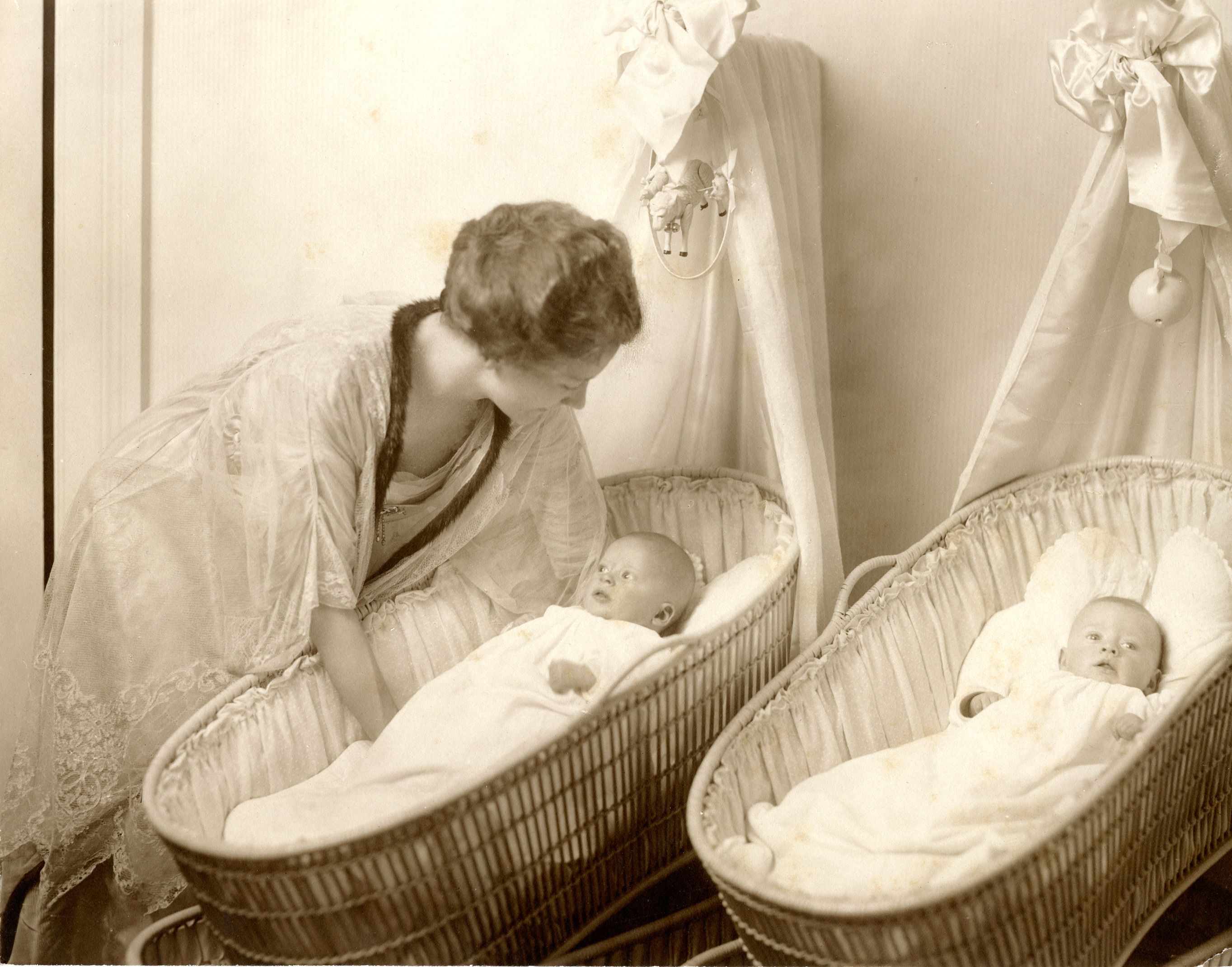
William Stirling was born in Stirlingshire, Scotland in 1851. The house where he grew up, which you can see pictured here in a more recent photo, was called Kippenross. He came to the U.S. in 1879 and became an officer of the Joliet Iron and Steel Company, later Illinois Steel – at this time it was run by Lord Leith, another Scottish transplant. He married Alice Hibbard, of one of Chicago’s founding families, and they had three daughters: Alice, Dorothy and Jean.
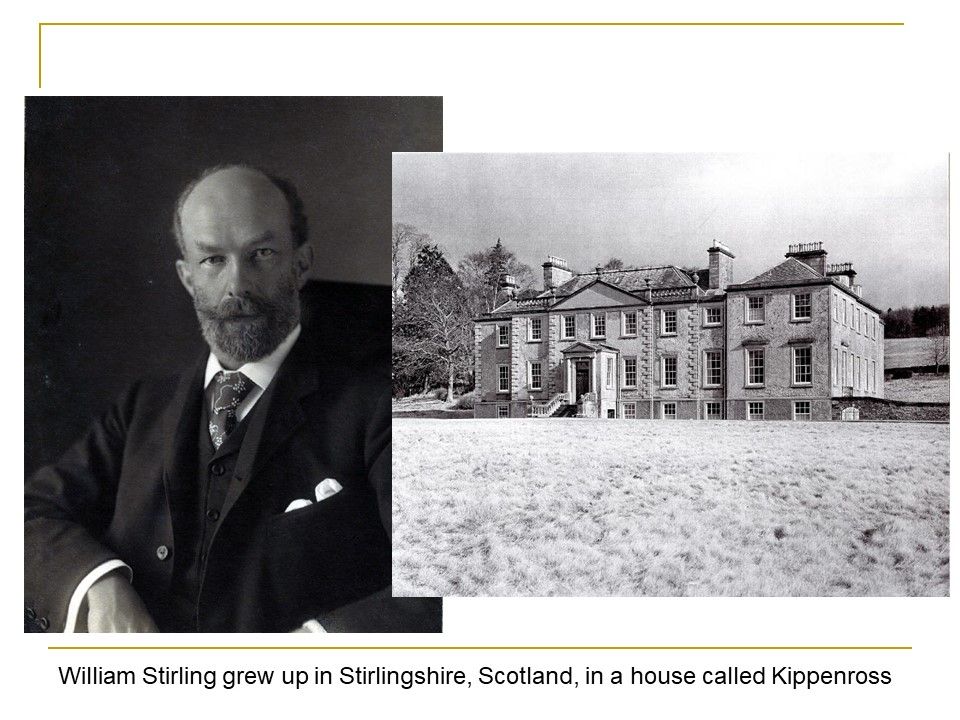
They built a home on Lake Road in the 1890s, near where it intersects Spruce – this house was later torn down and David Adler designed a home for the Bentleys in 1928 (today’s 1421 Lake Road) on the site. The Stirlings called their Lake Forest house “Birken Brae.”
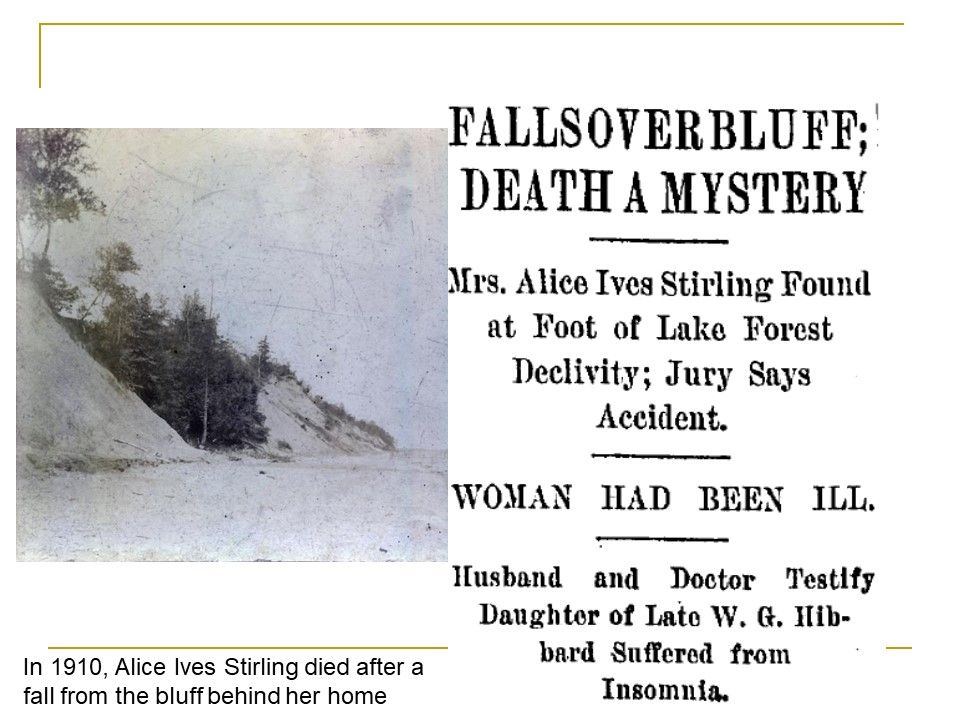
In 1910, the dangers of living directly adjacent to the lake shore struck the family intensely. William Stirling’s wife, Alice, suffered from insomnia and neuritis. One October night she sought some fresh air and, in the dark and damp, she fell 30 feet down from the bluff. The family found her there the next morning, dead from shock and exposure. She was 48 years old.
The Stirlings did not visit their Lake Forest residence as often after this tragedy and by 1920 had given it up entirely.
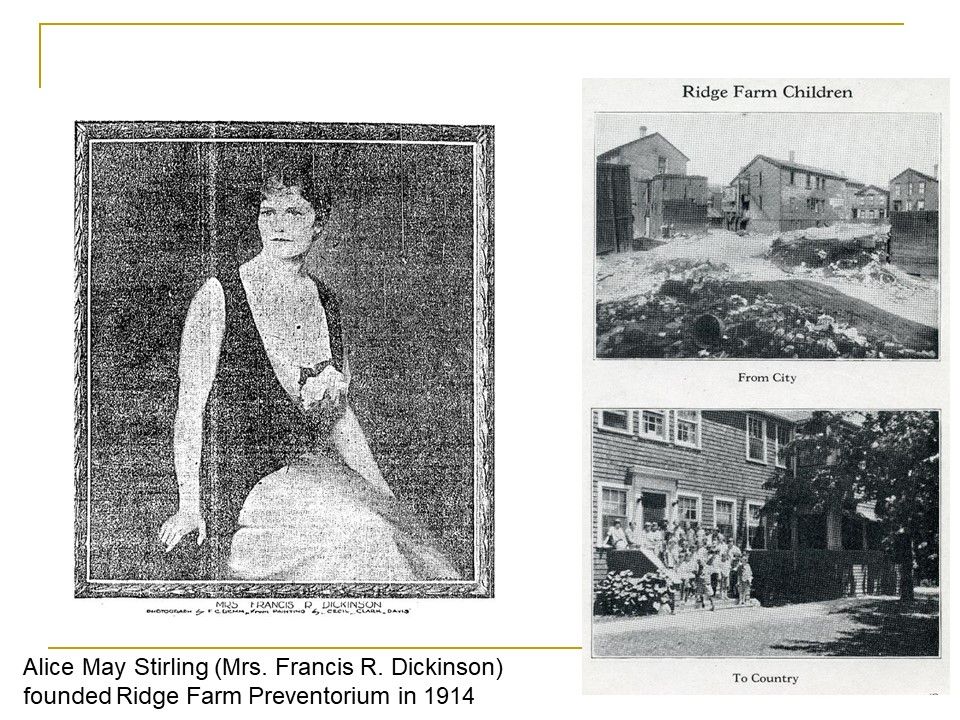
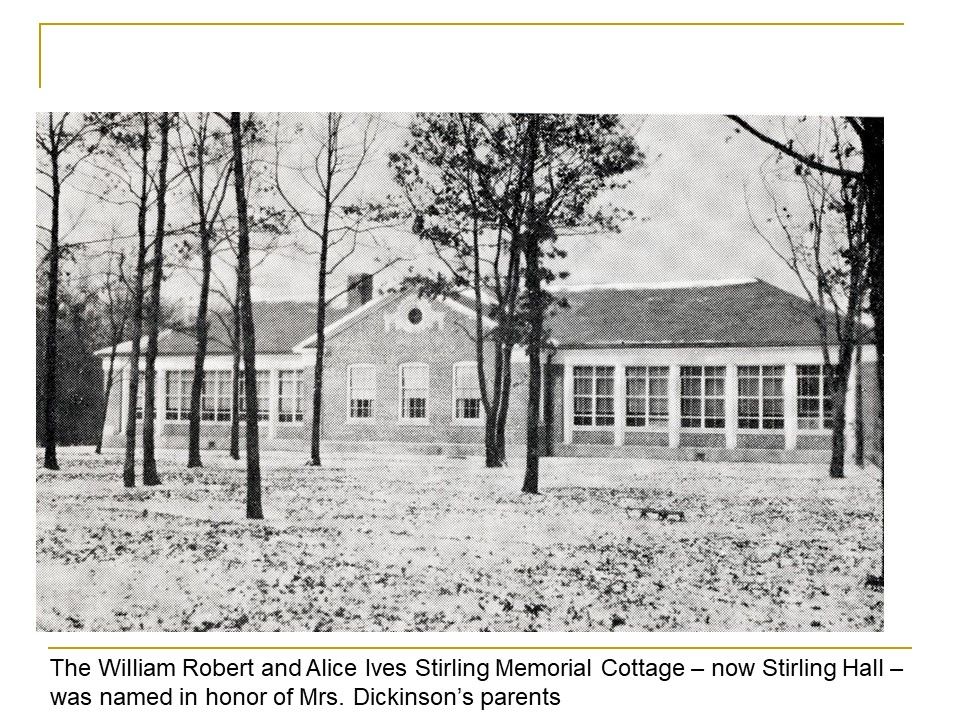
In the late 1920s, Alice May Dickinson was one of the major funders of Ridge Farm’s building program, including Dickinson Hall, where we are today, which was a dining hall, and the William Robert and Alice Ives Stirling Memorial Cottage across the way, today’s Stirling Hall, which was a dormitory. She had it named to honor her parents. The metal windows and exterior pilasters were believed to be incorporated into the design to honor William Stirling’s connection with the steel industry.
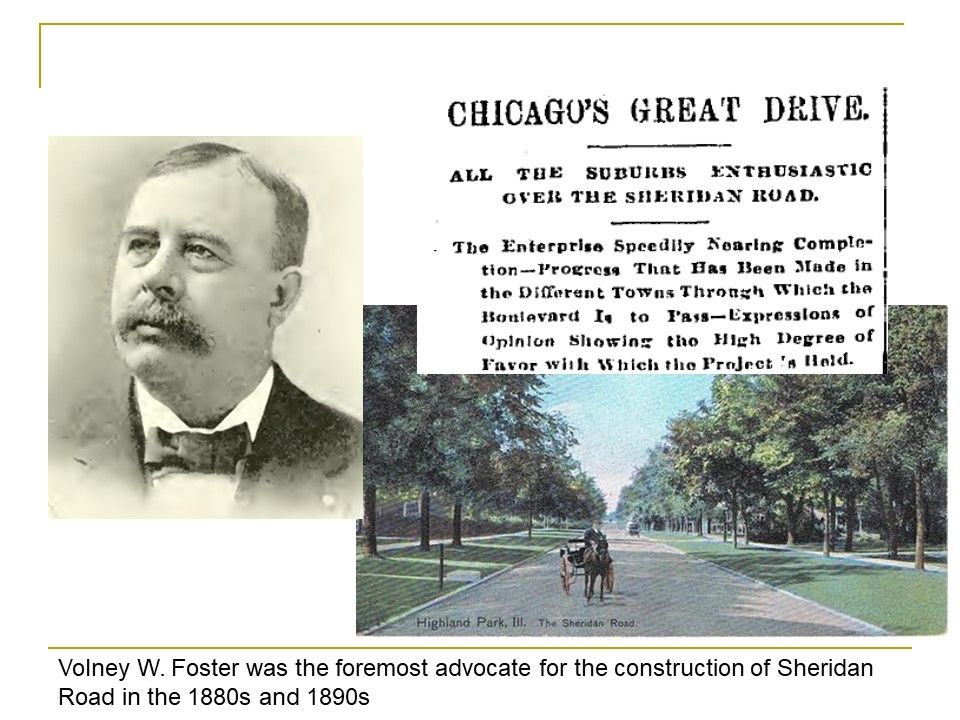
Volney William Foster was born in 1848 on a farm near Jefferson, Wisconsin. After a few years of teaching school, he came to Chicago in 1872, starting as a cashier for a lumber firm. You can imagine the volume of lumber that was needed in Chicago after the Great Fire. Within a few years he was able to purchase a lumber yard himself, out in Ontario.
He later became the head of Western Paving and Supply Company, which was formed in 1883, as well as the president of the Union League of Chicago. It was in this double capacity – paving materials dealer and community leader – that Volney Foster became the foremost advocate in the 1880s for the construction of Sheridan Road, a widened thoroughfare linking the lakefront suburbs to Chicago and ultimately up into Wisconsin. Volney Foster, himself an Evanston resident, organized the North Shore Improvement Association in 1889 to bring together principals from the various North Shore communities along the route. What ultimately sold the plan, which faced considerable opposition, given the number of governmental bodies and property owners involved, was linking it to the new Fort Sheridan, to facilitate access by soldiers to the labor disturbances in the city.
When Volney Foster died in 1904, 35 of the 85 miles had been completed of the planned lake shore drive between Chicago and Milwaukee. He’s been known since then as the “father of Sheridan Road.”
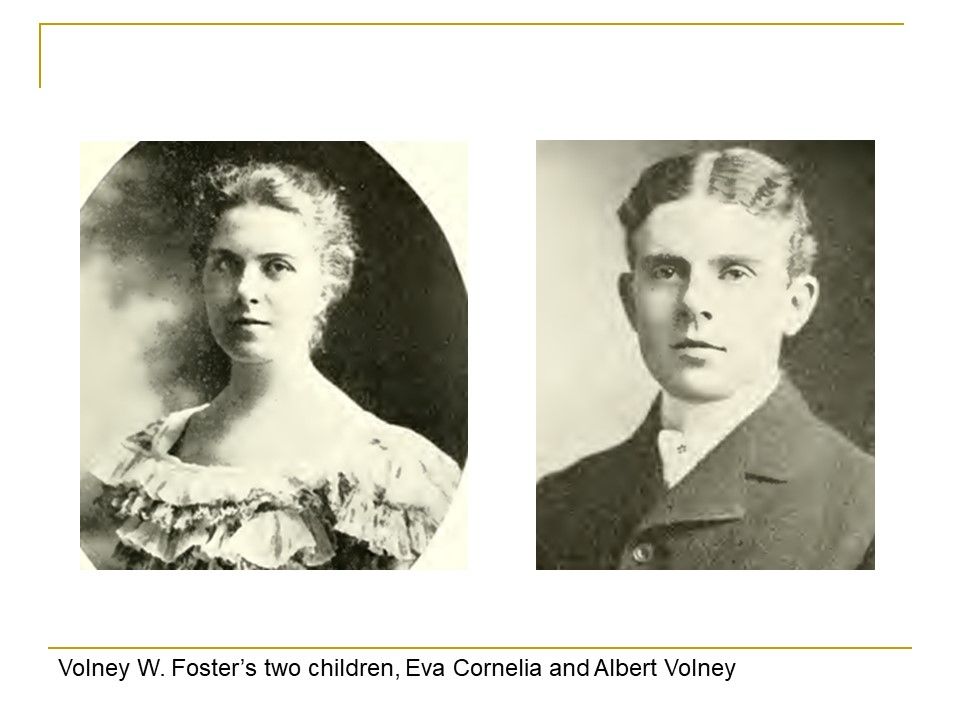
Volney Foster had two children, Albert Volney, born in 1877, and Eva Cornelia, born in 1879. Eva Cornelia married Walter L. Righter and lived in Pennsylvania. Albert Volney Foster became a vice-president at North Shore Gas, and in 1906 married Grace Leslie, who died less than a year after their daughter Leslie was born in 1907.

In 1913 Albert Volney Foster remarried, this time to a southerner, Margaret Baxter. Margaret was the daughter of George White Baxter and Margaret McGhee Baxter of Knoxville, Tennessee. George Baxter had served as territorial governor of Wyoming in 1886, and indeed Margaret had been born out in Cheyenne.
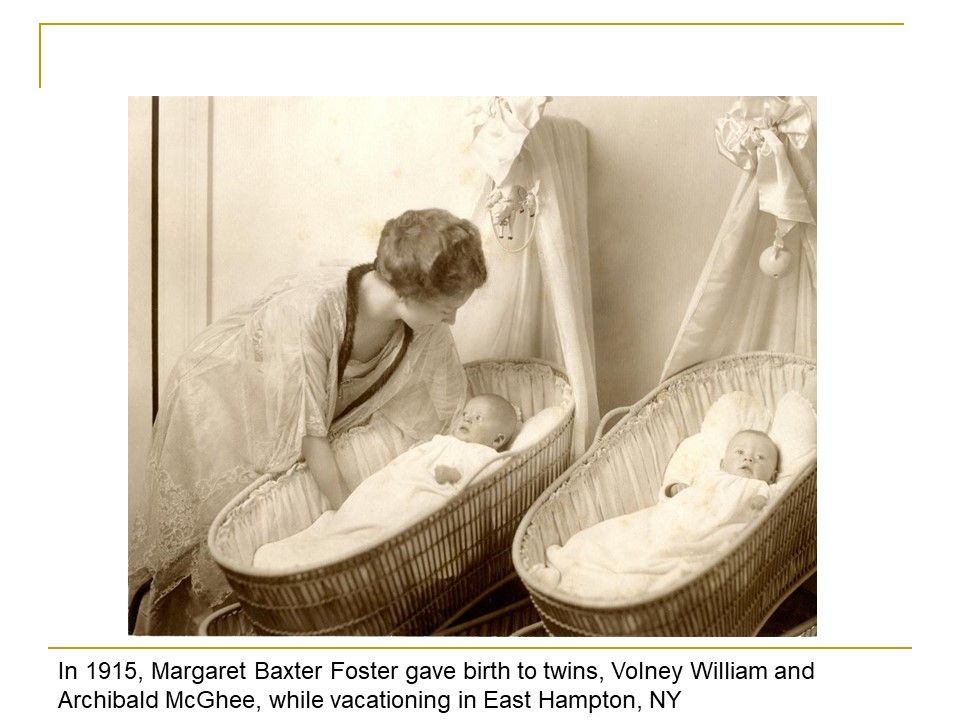
In August 1915, while vacationing in East Hampton, New York, Margaret Baxter Foster had a bit of a surprise – her baby was born a bit early, and he was born twice, it were – she (unexpectedly) gave birth to twins, who were named Volney William (after his grandfather) and Archibald McGhee.
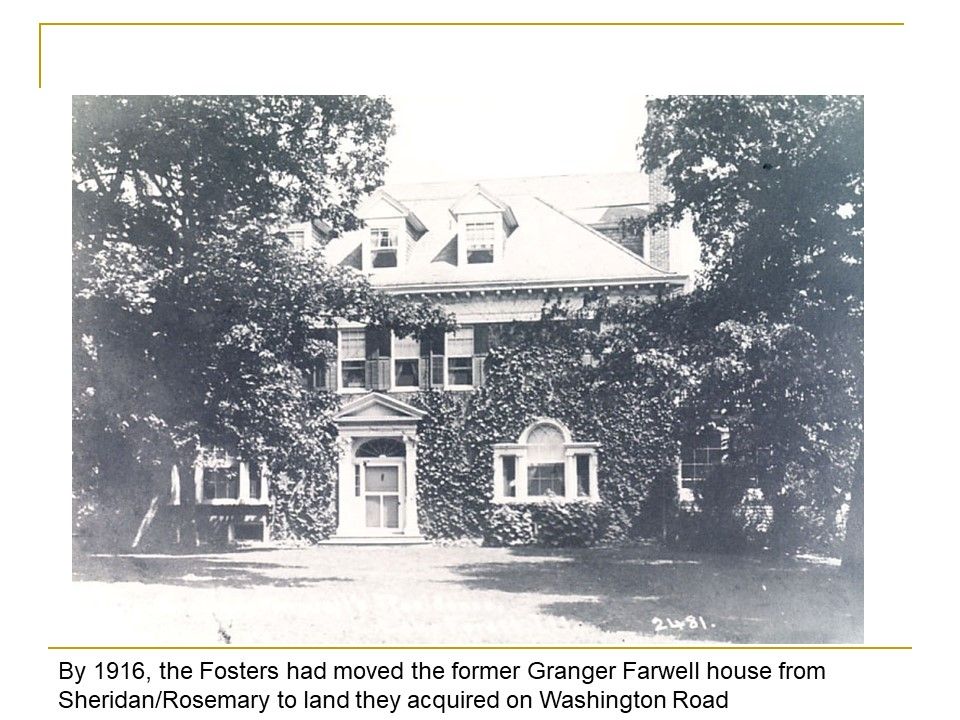
This growing family needed a larger house. In 1915, the Fosters had purchased land on Washington Road in Lake Forest, and soon a house became available as well. This was the former Granger Farwell home at the northeast corner of Sheridan and Rosemary. The Fosters elected to have the house moved to their lot at 400 Washington Road, but for several months Rosemary Road remained blocked off as the crew attempted to maneuver the large residence through the muddy street and overhanging trees.
In 1924 this house suffered a devastating fire, with damage estimated at $50,000 and fortunately no one hurt. Lake Forest historian Edward Arpee wrote an account of the event, “A great crowd from all over town gathered to help or be entertained. Fire departments from Glencoe and North Chicago arrived. The heat could be felt far beyond the street. Crowds of people salvaged furniture. Mirrors and chairs were thrown out windows, while pillows were gingerly carried down to safety. The top floor was completely burned out, the second floor was partially destroyed, the first floor ruined by water.” After this the home was extensively renovated.
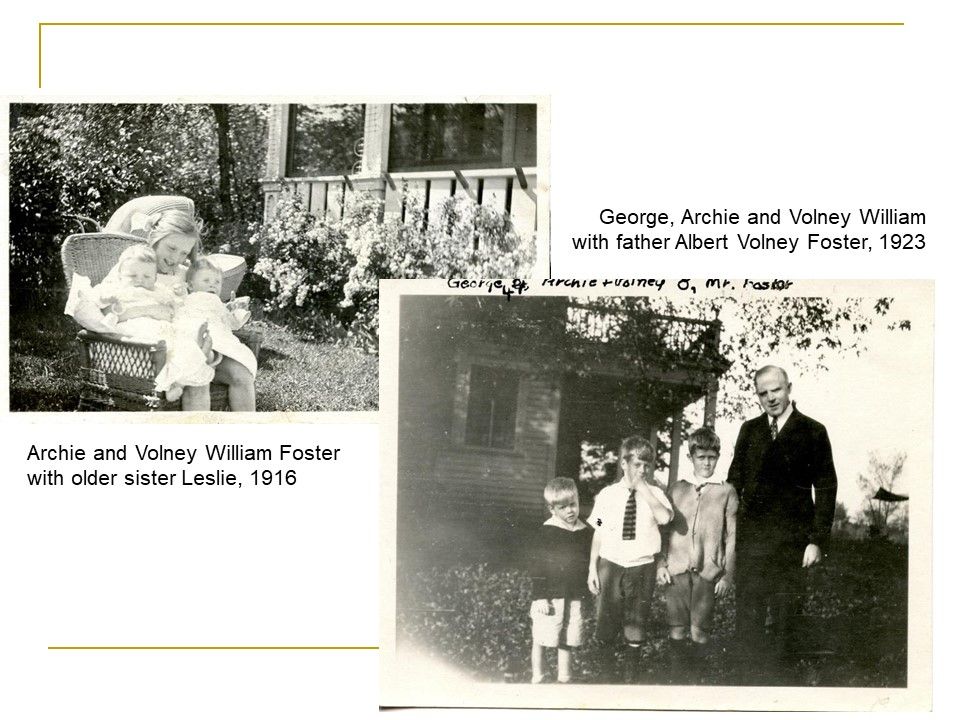
A third son was born to the Fosters in 1918, George Baxter. Here you can see photographs of the Foster twins with their sister Leslie, and the Foster boys with their father in 1923.
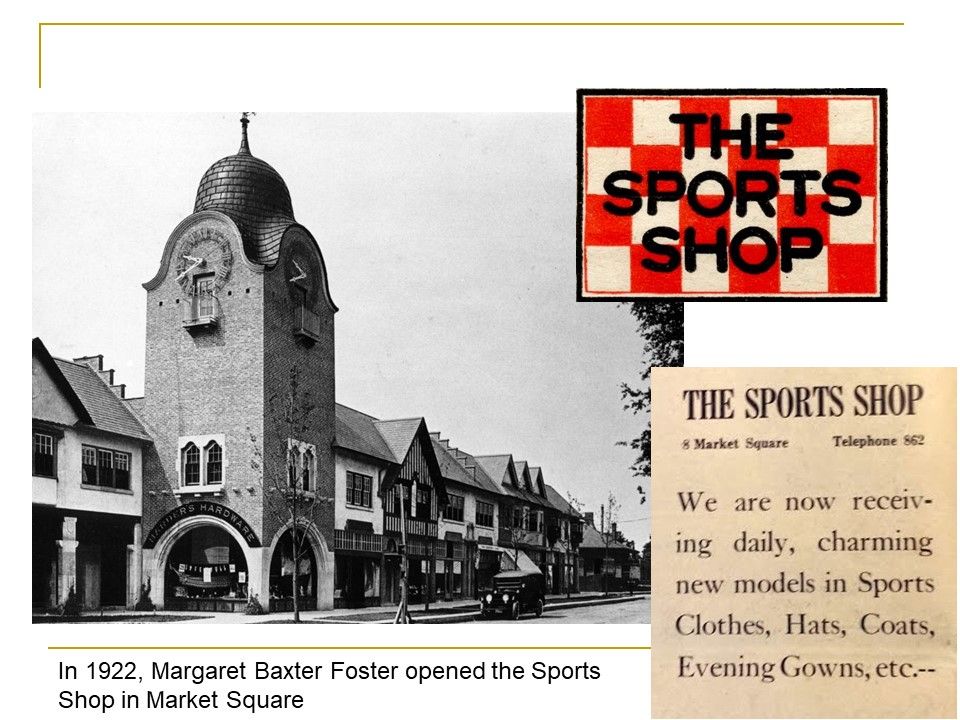
Like many women of the time – indeed, many people of the time – Margaret Baxter Foster enjoyed shopping for clothes, and did so extensively, particularly on the family’s trips abroad. But not many women of the time had her eye for fashion, or the drive required to turn an enjoyment of shopping into a groundbreaking career, which is what she did. One day Margaret decided (or perhaps her husband suggested) that it might be a good idea to clean out her closet and put items from her massive wardrobe for sale.
This was the foundation of the Sports Shop, which opened in Market Square in 1922. Many of Margaret Foster’s pieces were separates and were considered sportswear, which was ahead of the fashion curve of the time – a whole new way of dressing. Sportswear was then beginning to transition from long tennis dresses and bathing costumes to the new trousers, blouses, and shorter skirts.
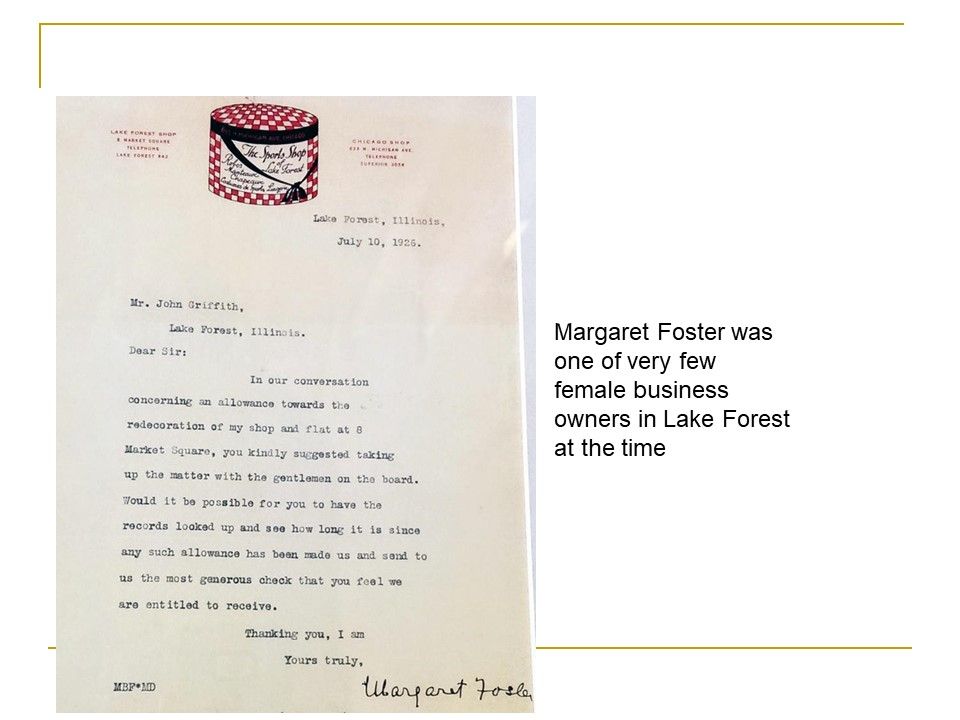
Margaret Foster hired Millie Duncan as the day-to-day manager, while she went on buying trips, and would be in and out of the store. She was nonetheless one of very few female business proprietors in Lake Forest at the time, and constantly had to negotiate what was essentially a gentlemen’s club. You can see the fine line she had to walk in this 1926 letter to John Griffith, who managed the Market Square property: “In our conversation concerning an allowance towards the redecoration of my shop at 8 Market Square, you kindly suggested taking up the matter with the gentlemen on the board. Would it be possible for you to have the records looked up and see how long it is since any such allowance has been made us” – I’m guessing it had been awhile – “and send to us the most generous check that you feel we are entitled to receive.”
Her shop and its approach proved to be a success, catering to the right population at a time of rapid change in the world of fashion. Soon satellite locations of the Sports Shop were opened in Hubbard Woods and on Michigan Avenue.
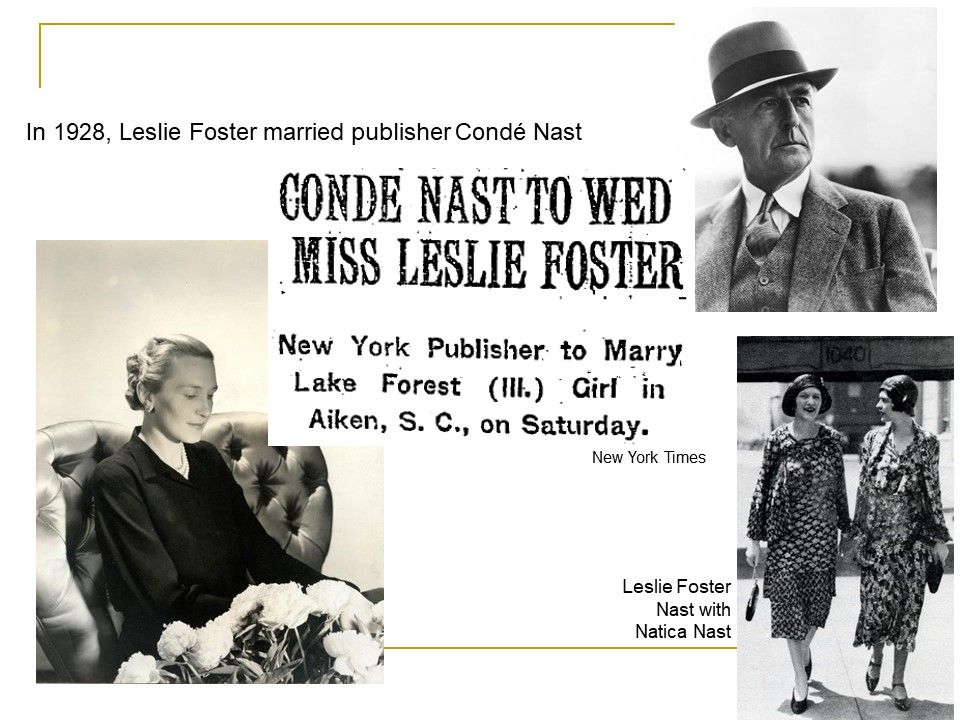
Margaret Foster was spurred on in this success by both her fashion acumen and her connections. In 1928, her husband’s daughter Leslie Foster married the world-renowned publisher, Condé Nast, whose portfolio of publications included Vanity Fair and Vogue. Leslie was 20 and her new husband 55 – indeed, she and his daughter Natica Nast, from his first marriage, were the same age and became great friends.
They had one daughter, Leslie, in 1930, but the marriage did not last, and in 1932 they were divorced. Leslie then married Reginald Lindsay, or Sir Rex, Benson. Sir Rex was Chairman of Kleinwort Benson, his family's London based investment banking firm. As the story goes, Rex approached Conde Nast and confessed he had fallen for the publisher’s wife. Conde replied, “My dear boy, please take her. She’s too young for me.”
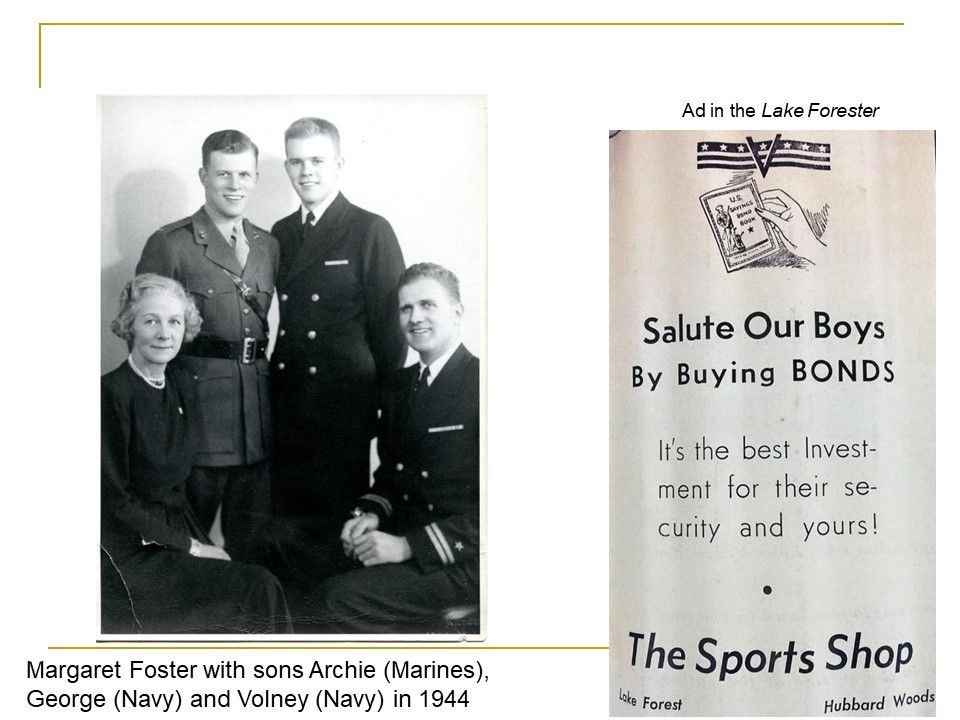
The Fosters’ three sons all served in World War II, Archie in the Marines and George and Volney in the Navy. On the homefront, this Sports Shop advertisement in the Lake Forester urged patrons to buy War Bonds.

Volney William Foster, a graduate of Harvard and then of Harvard Business School in 1940, served as an ensign, and then as a lieutenant in the naval reserve. He was on sea duty in California in 1942 when he married Adair Orr. The two had originally met at a party in Lake Forest at the ages of 16 and 13, respectively.
Later in the war, Volney Foster commanded an LST, or Landing Ship, Tank, in the Mediterranean.

Ellen Adair Orr Foster – she went by Adair – had grown up in Chicago, attending the Latin School and the University of Chicago. Her first job was managing fashion shows and other merchandising events in the fashion offices of Marshall Field – excellent training for the fashion-oriented family she was marrying into.
Her parents were Robert C. Orr and Ellen Augur. Robert Orr was an investment broker who had served with the British Red Cross Ambulance service even before America entered World War I.

Through her mother, Ellen Augur, Adair Orr Foster had a connection to old Lake Forest. Her grandfather Walter Wheaton Augur had been among the founding members of the Onwentsia Club in 1895.

Adair Orr Foster had one sister, Nancy, who in 1945 married Rudolf Talbot. His father opened a Johnny Appleseed clothing store in 1945, but died suddenly, forcing Rudolf and Nancy to take over the store. Disliking the merchandise, the Talbots dropped the Johnny Appleseed franchise in 1947 and opened a new store, in Hingham, Massachusetts, which they called Talbots. Little did Nancy know that by the 1980s, Talbots would open a location in Market Square, just a few storefronts down from her sister’s Lake Forest Sports Shop. And Adair would see her sister’s handwriting in the Talbots logo out the window every day.
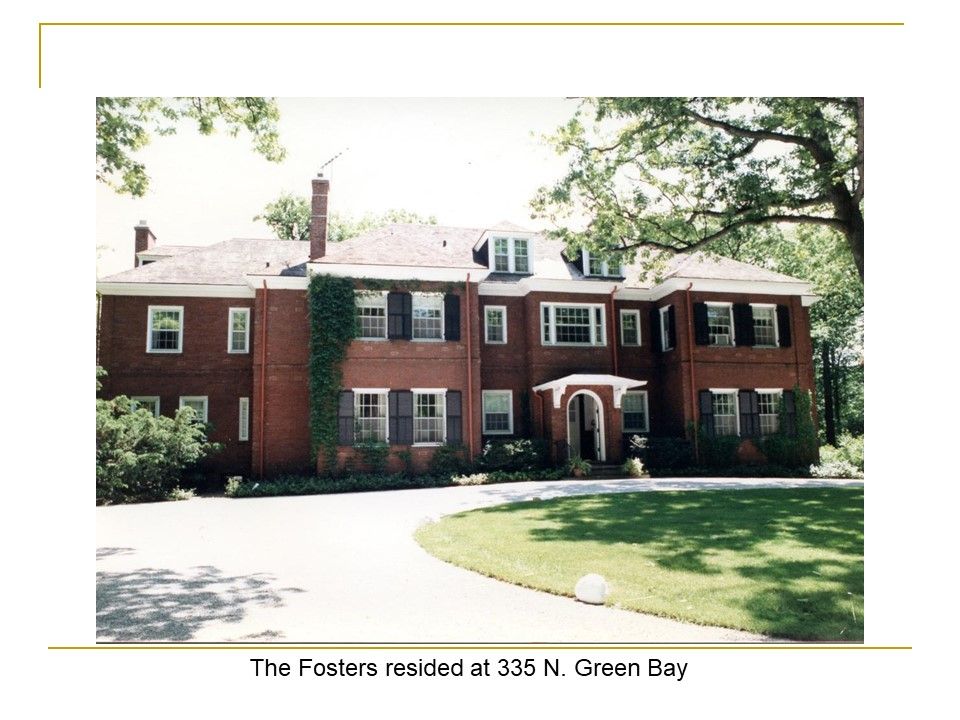
After the war the Fosters lived at 335 North Green Bay Road, a house designed by architect Arthur Heun in the 1890s for former Lake Forest mayor Fredrik Herman Gade, named “Frogner” after his childhood home in Norway.

Volney and Adair Foster had three children: Ellen Adair, David Volney, and Sally Orr. You can see them pictured with their parents in 1955 on the porch at 335 Green Bay, and then David with the two previous generations of Volney Fosters in 1948.
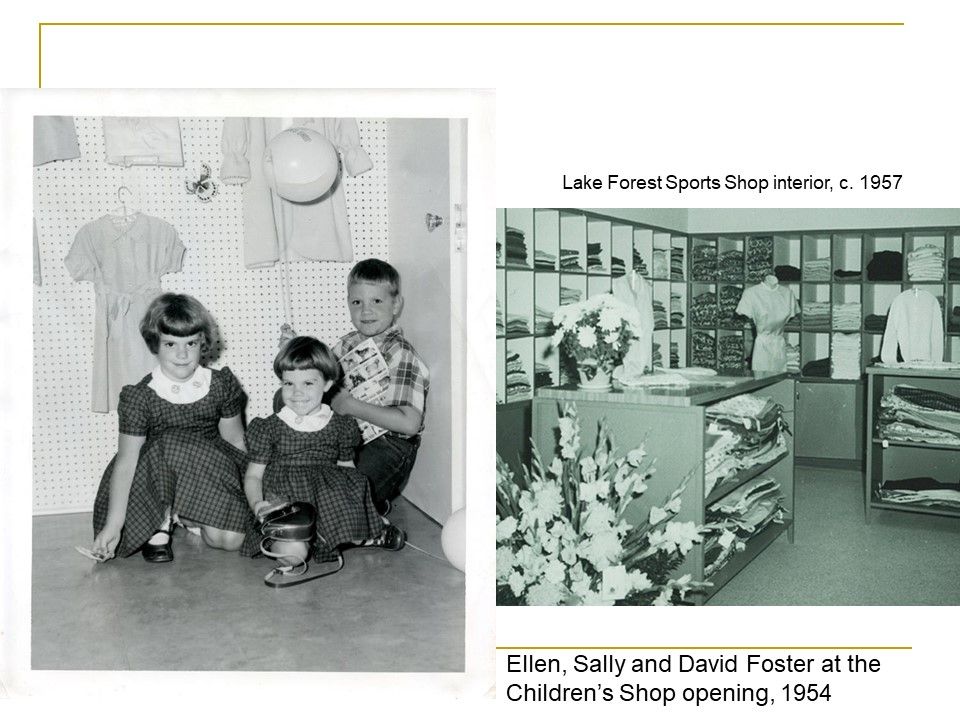
Volney and Adair Foster took over the Lake Forest Sports Shop from Margaret Baxter Foster in 1949. Volney was chairman, while also working as a partner at William Blair and Co.; Adair concerned herself more with the fashion collections and day-to-day operations. Their children were just the right age in the 1950s when they remodeled and expanded the store and opened the Children’s Shop, adding clothing for young people to the merchandise mix.

These photographs show Adair and Volney Foster and the Lake Forest Sports Shop façade at the shop’s 50th anniversary in 1972. At that time, it was one of several long-running family businesses in downtown Lake Forest – now, of course, it is the only one in Market Square that has stood the test of time and remained in the family.
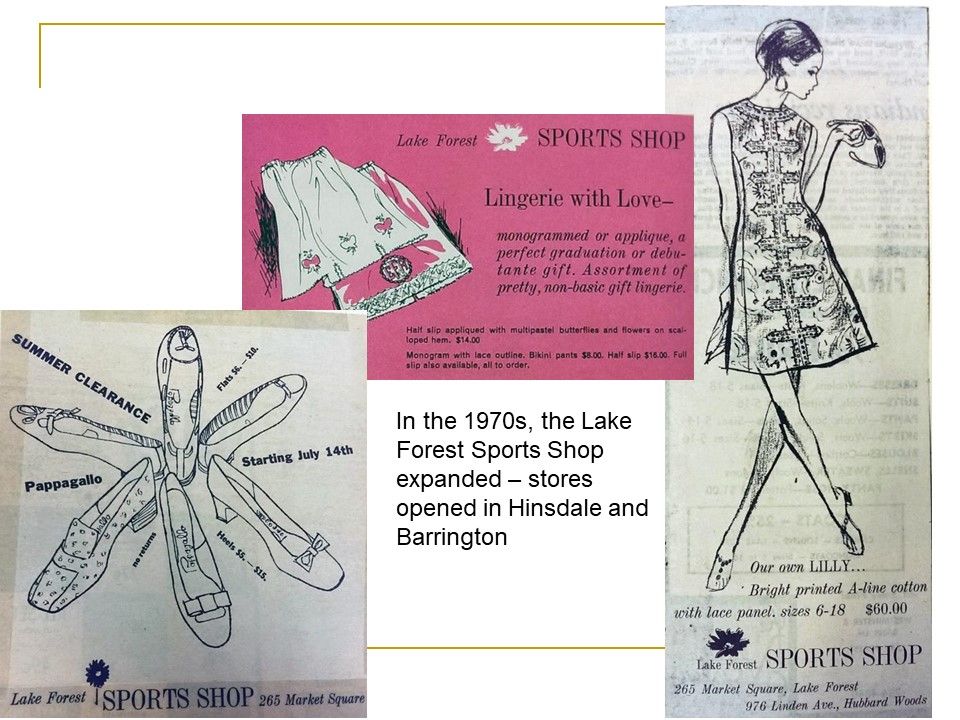
Brisk sales in the 1970s encouraged the Fosters to open two more satellite locations, in Hinsdale and Barrington. Here you can see some advertisements from the time period showcasing classic brands like Pappagallo and Lilly Pulitzer.
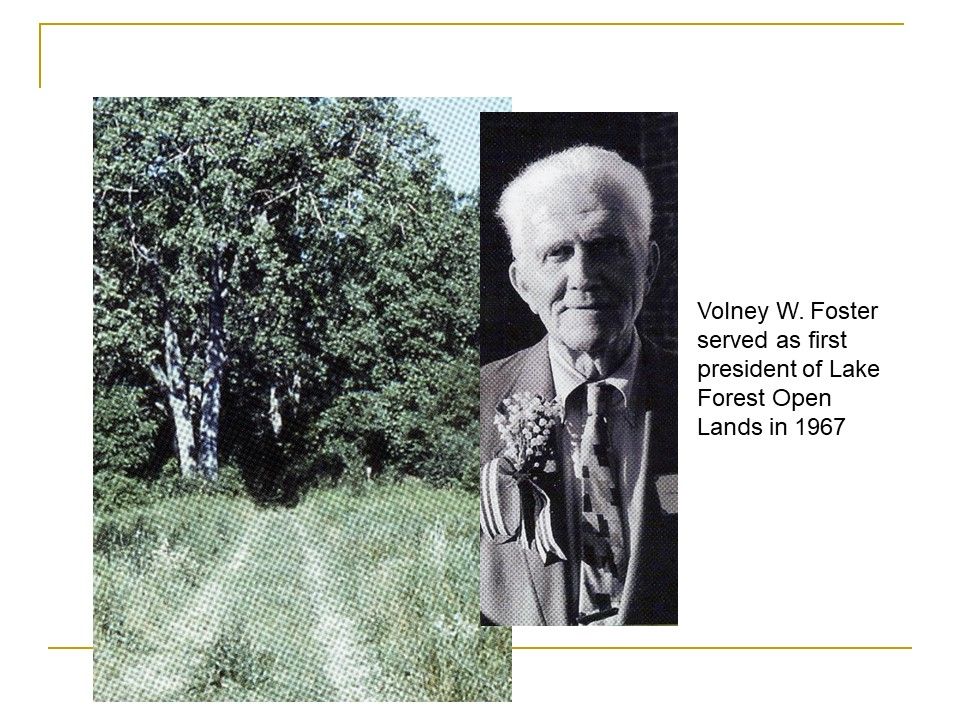
Volney Foster was the founding president of Lake Forest Open Lands Association in 1967. He said in a newspaper article at the time that, “It is the responsibility of the community residents to help themselves and find solutions to community problems. This is why the association was formed.” Overdevelopment was becoming a problem in many suburbs, and Lake Forest, which prided itself on its open spaces, did not want to go down that road. Foster helped secure the first Open Lands gifts of property along Green Bay Road and the Skokie, the Shaw Prairie, where he is now honored.

Adair Foster was active in the Lake Forest Garden Club, serving as president from 1980 to 1982. Here you can see her pictured in 1985 in Triangle Park, which the Garden Club has preserved and beautified through the years.
Adair Foster’s daughter, Ellen, has honored her mother through the Adair Foster Room at the Elawa Farm Foundation, sponsoring horticultural projects and education. Elawa is fittingly adjacent to Open Lands property, the great legacy of her father Volney Foster.
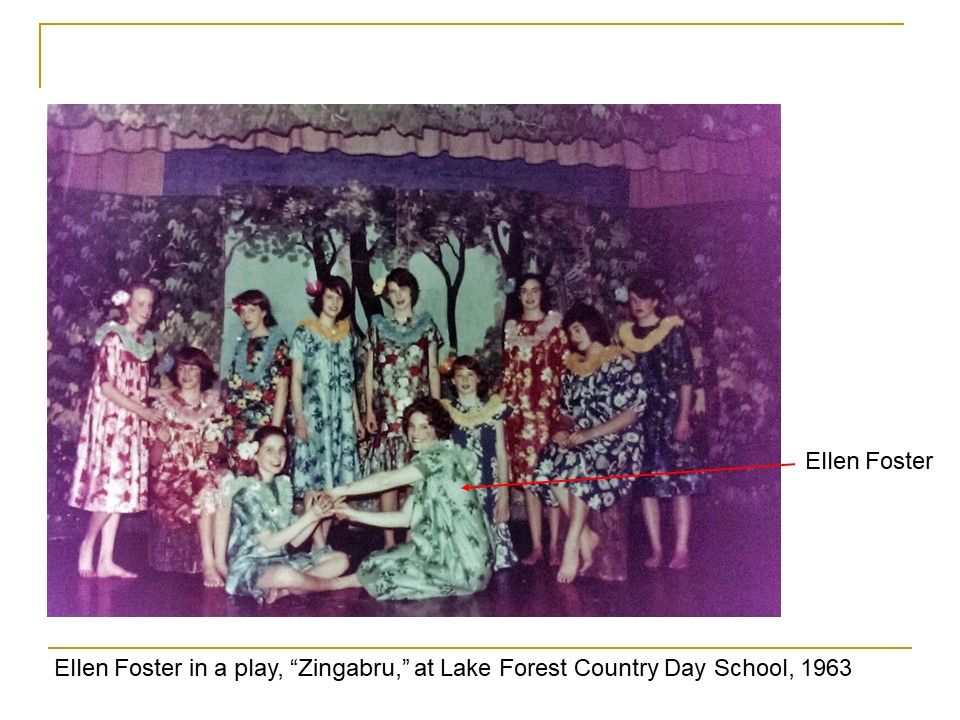
The Foster children attended Lake Forest Country Day School, where their father served as chairman of the board of directors. You can see Ellen Foster pictured here in a 1963 theatrical production.
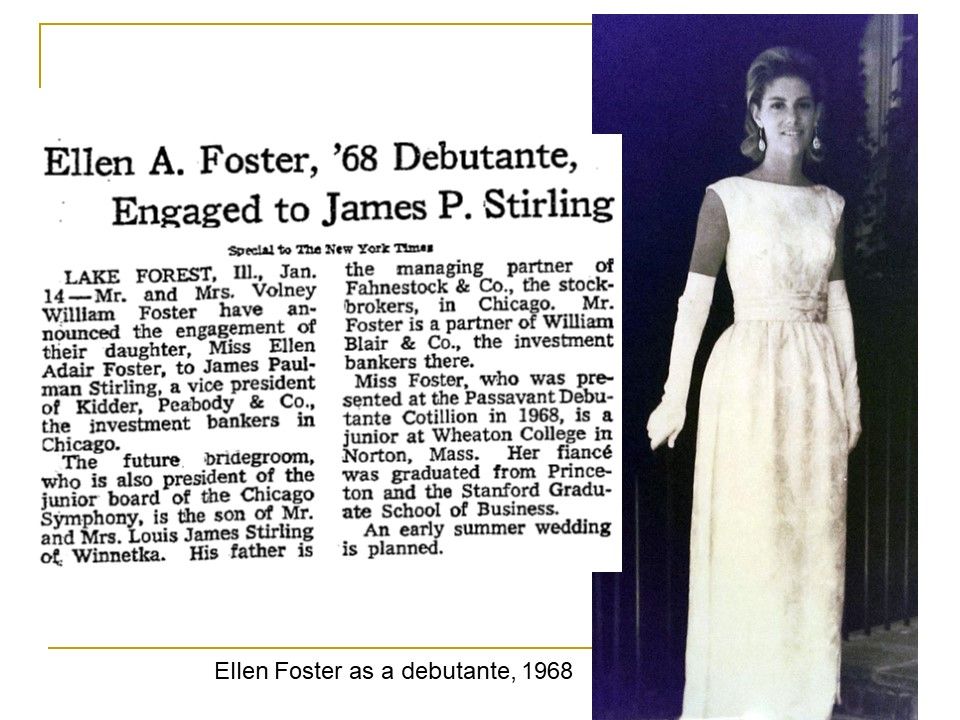
After Lake Forest Country Day, Ellen attended school at St. Timothy’s in Maryland and then studied art history at Wheaton College in Massachusetts. She met her future husband James Stirling at a party at the Casino Club, shortly after her debut in 1968. Her mother had given her specific instructions for awkward situations at such parties: if you’re alone, don’t be a wallflower, don’t go to the bathroom – go to the bar! So she did, and then Jim Stirling turned around, with two drinks in his hand.
Jim Stirling’s great-grandfather, as I mentioned, was a cousin of the William Stirling who lived in Lake Forest at the turn of the century. As you can see from the clipping I’ve pulled from the society pages of the New York Times, he was from Winnetka and had attended Princeton and Stanford Business School and was working with the investment firm Kidder, Peabody & Co.
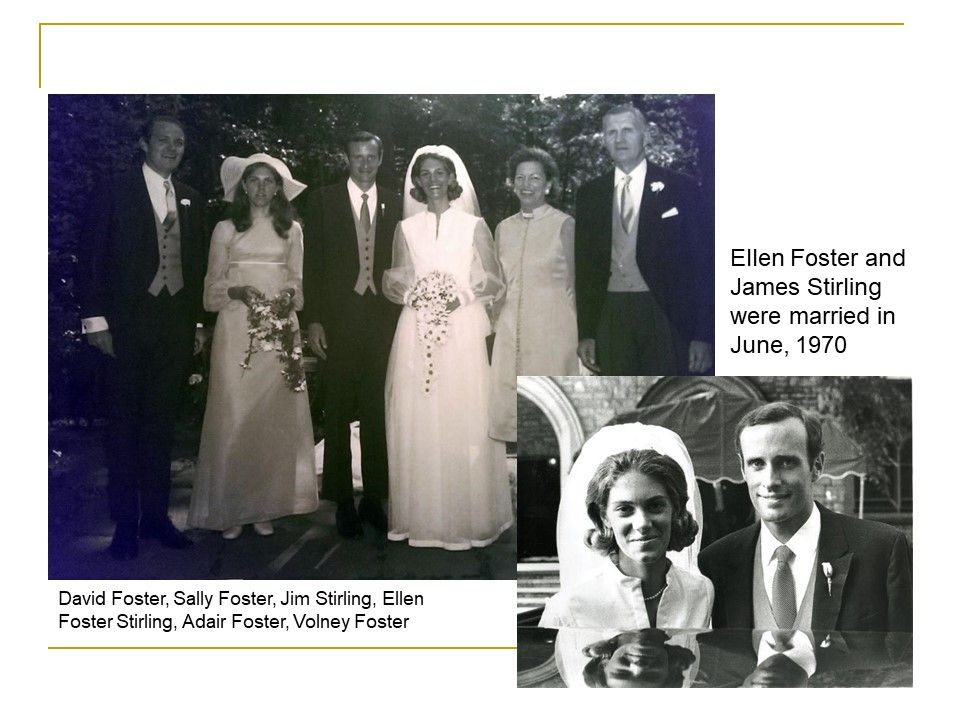
Ellen Foster and Jim Stirling were married in 1970 at the Church of the Holy Spirit in Lake Forest. They were a well-matched pair through their passion for the arts. Jim Stirling founded the Junior Board of the Chicago Symphony Orchestra. With his encouragement, Ellen did the same thing for the Art Institute, helping to create Auxiliary Board in 1973, which began with just a few and now has over 60 members to champion museum education, lecture series, outreach programs, exhibitions, and fund-raising events.
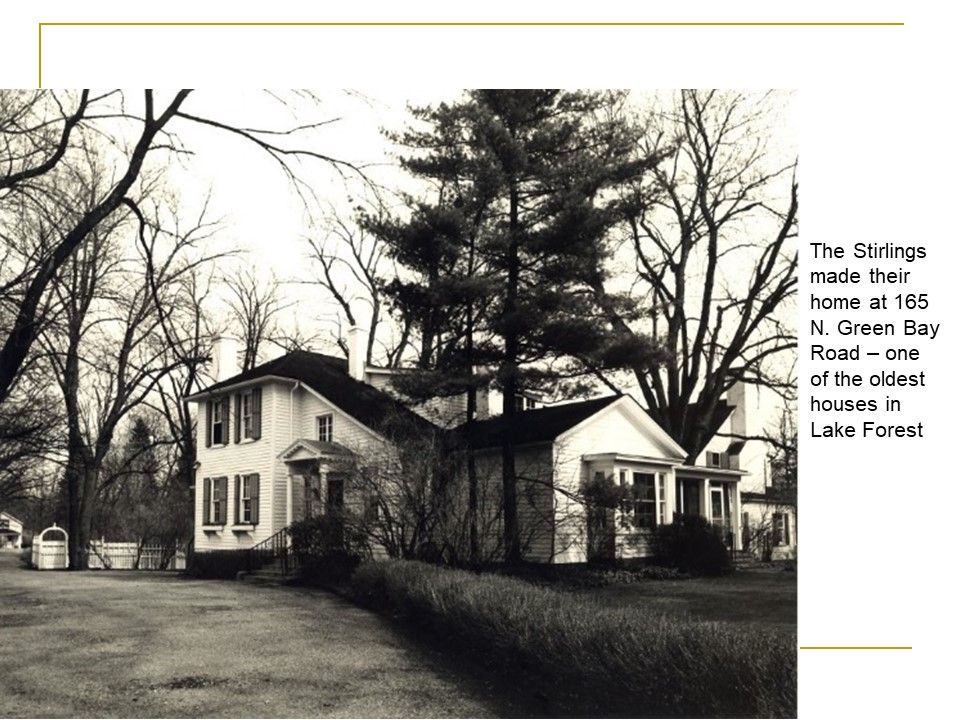
In 1975, the Stirlings bought 165 North Green Bay Road – one of the oldest, and most interesting, houses in Lake Forest. It had been owned by the John Andrews King family for the previous 50 years. The house was said to have been formed in the first few decades of the 20th century by drawing together two older buildings – a circa 1858 post office from Western Avenue and an old schoolhouse. It was remodeled in the 1920s by Stanley Anderson and in the 1930s by David Adler, who designed the balustraded terrace.
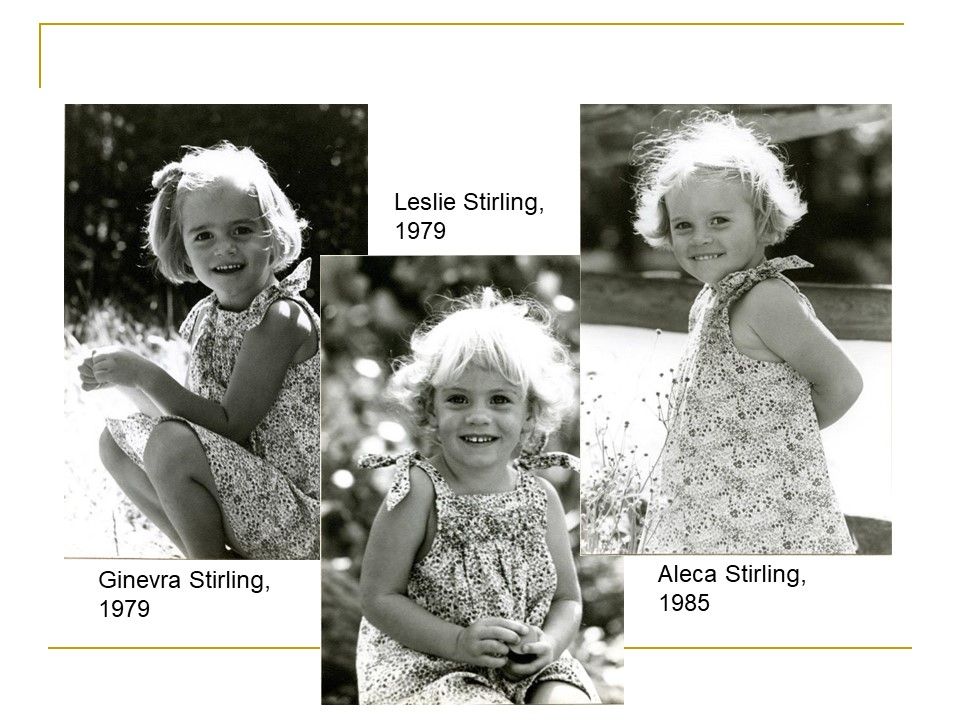
The Stirlings had three daughters: Ginevra, Leslie, and Alexandra or Aleca. The lovely photographs you see here were taken of the girls at ages 3 or 4 by local photographer Jean Campbell Farwell.

Lake Forest Country Day School became a family tradition for the Stirlings, as you can see in this 1998 photograph of four graduates: Leslie in 1991, Aleca in 1998, Ellen in 1963, and Ginevra in 1990.
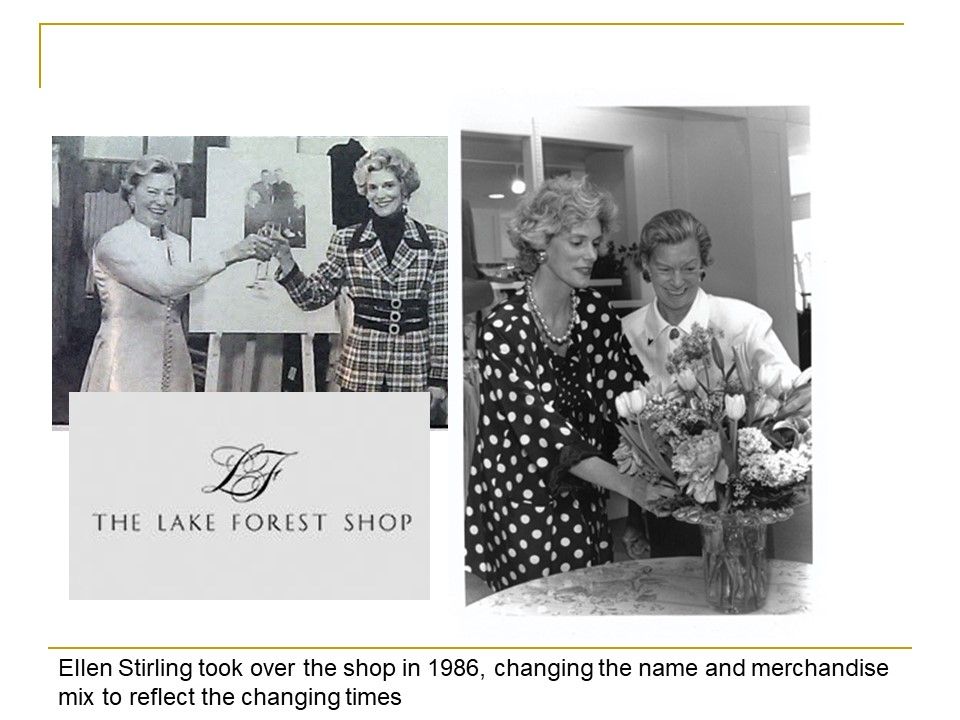
In the 1980s, the Lake Forest Sports Shop’s brand began to struggle, and after the stores had amassed half a million dollars in debt, the Fosters considered selling it. But their daughter Ellen Stirling, recently returned from working in fashion in England, recognized the uniqueness of the concept and thought it still had plenty of promise, so in 1986 she told her parents that she would be interested in taking over the store.
She had her work cut out for her, recalling that during the Christmas shopping season that year a man had stopped in and asked where he could find the bowling balls. By the 1980s, the connotation of a “sports shop” had transitioned from clothing separates to tennis rackets and baseball bats. A name change was in order, and the store became the Lake Forest Shop.
Ellen Stirling made a number of other strategic decisions designed to restore the shop’s success: she put all her eggs in one basket and closed satellite locations, she revamped the selection, and remodeled the shop’s interior in 1987. Then she started hosting trunk shows, which was unheard of at the time. By her parents’ 50th wedding anniversary in 1992, she was able to pay off the store’s debt and had a promising roadmap for its future.
This was underlined in 1998 when fashion designer Bill Blass named Lake Forest women as the among the best dressed in the country in an issue of Travel & Leisure magazine, citing the Lake Forest Shop as one of the reasons.
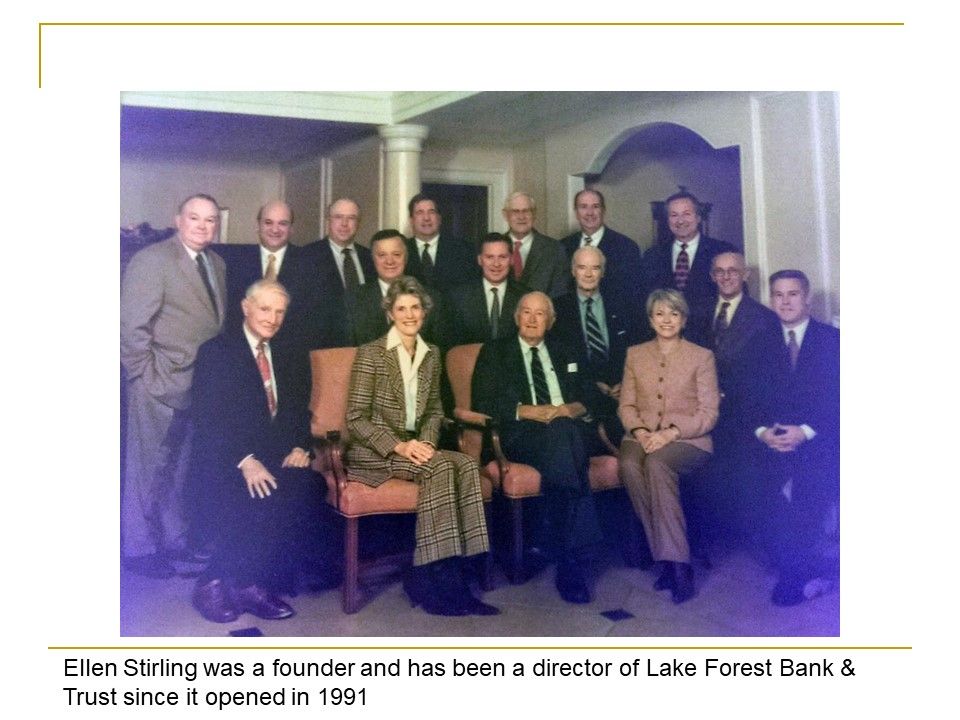
In addition to the Lake Forest Shop, Ellen Stirling was a founder and remains an active director of Lake Forest Bank & Trust, recalling the day it opened its doors in December 1991.
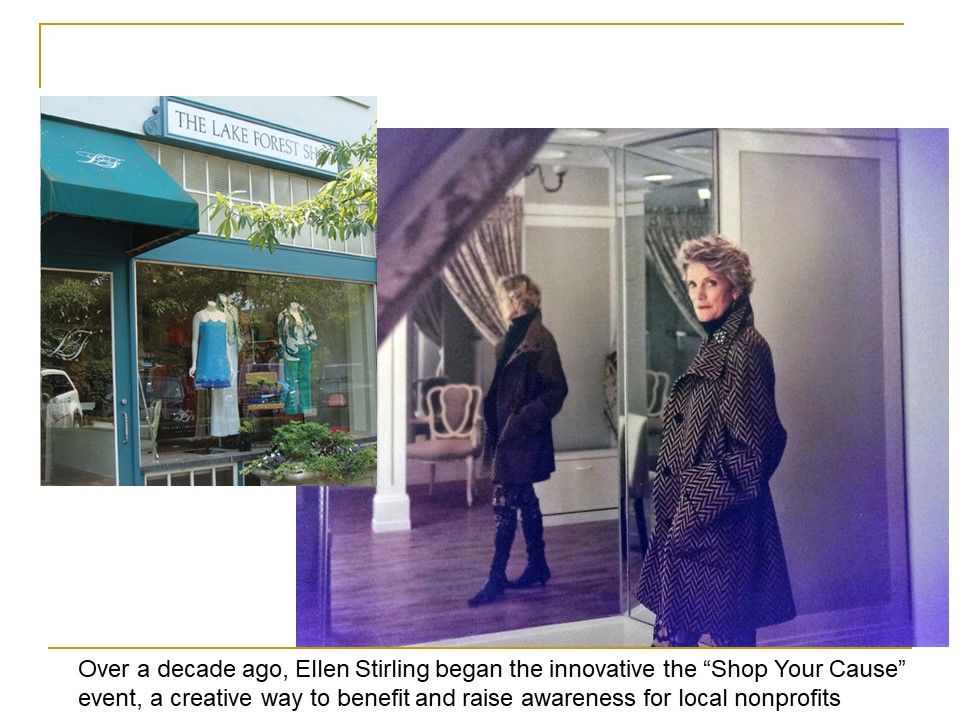
Another of Ellen Stirling’s innovations is “Shop Your Cause,” a yearly shopping event held at the Lake Forest Shop that began over a decade ago. The proceeds from shoppers’ purchases go back to a local charity of their choosing – a scheme reflecting her belief that these non-profits are the soul of our town.

This belief is borne out through the numerous ways the Stirlings have been involved with the Lake Forest and Chicago community: Lake Forest Open Lands, Elawa Farm Foundation, the Lake Forest Garden Club, Northwestern Lake Forest Hospital, the Art Institute, the Chicago Symphony Orchestra, the Lyric Opera, and others.
Through the Rehabilitation Institute in Chicago, her efforts also overlapped with that of a member of our other Centennial Family, Jim Heyworth. Working beside the legendary Dr. Henry Betts, Ellen Stirling was appointed to lead a task force in the early 1970s, to find ways to make the city of Chicago more accessible for the disabled. Innovative ways to allow those in wheelchairs to get around the city with ease were born in those meetings and soon became law.
Beyond all this, the most important family legacy is, of course, their children and grandchildren, seen in these recent photographs here.